Kenneth C. Davis's Blog, page 13
May 29, 2023
GREAT SHORT BOOKS: A Year of Reading–Briefly

Two boxes of beautiful finished books have arrived (Author photo)
GREAT SHORT BOOKS:
A YEAR OF READING — BRIEFLY
NOW AVAILABLE
Scribner/Simon & Schuster and Simon Audio (Unabridged audio download)
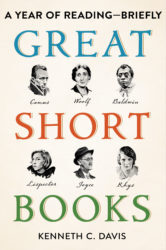
“An exciting guide to all that the world of fiction has to offer in 58 short novels — from ‘The Great Gatsby’ and ‘Lord of the Flies’ to the contemporary fiction of Colson Whitehead and Leïla Slimani — that, ‘like a first date,’ offer pleasure and excitement without commitment.” New York Times Book Review
Booklist “Editors’ Choice Adult Books 2022″
“…The most exceptional of the best books of 2022 reviewed in Booklist…”
“Delightfully accessible, Great Short Books: A Year of Reading–Briefly presents 58 fact-filled reviews of short books, a smorgasbord of titles sure to entice readers.” –Cheryl McKeon, Shelf Awareness
“I consider Davis’ ‘Great Short Books’ a gift to readers, a true treasure trove of literary recommendations.” —Sue Gilmore, SFGate
“Anyone who’s eternally time-strapped will treasure Kenneth C. Davis’ Great Short Books. This nifty volume highlights 58 works of fiction chosen by Davis for their size (small) and impact (enormous). Each brisk read weighs in at around 200 pages but has the oomph of an epic.” —Bookpage Full Review
“An entertaining journey with a fun, knowledgeable guide…. “ Kirkus Reviews
“A must-purchase for public and school libraries.” ALA Booklist
FIRST TRADE REVIEWS FROM KIRKUS, PUBLISHERS WEEKLY, BOOKLIST
“Davis feels that novels of 200 pages or less often don’t get the recognition they deserve, and this delightful book is the remedy…A must-purchase for public and school libraries.” *Starred Booklist review
“An entertaining journey with a fun, knowledgeable guide…. His love of books and reading shines through. From 1759 (Candide) to 2019 (The Nickel Boys), he’s got you covered.” –Kirkus Reviews
Full KIRKUS review here
“Davis’s conversational tone makes him a great guide to these literary aperitifs. This is sure to leave book lovers with something new to add to their lists.” FULL PUBLISHERS WEEKLY REVIEW here
During the lock-down, I swapped doom-scrolling for the insight and inspiration that come from reading great fiction. Inspired by Boccaccio’s “The Decameron” and its brief tales told during a pandemic, I read 58 great short novels –not as an escape but an antidote.
“A short novel is like a great first date. It can be extremely pleasant, even exciting, and memorable. Ideally, you leave wanting more. It can lead to greater possibilities. But there is no long-term commitment.”
–From “Notes of a Common Reader,” the Introduction to Great Short Books
Read “The Antidote to Everything,” an excerpt from the Introduction published on Lit Hub
The result is a compendium that goes from “Candide” to Colson Whitehead, and Edith Wharton to Leïla Slimani. And yes, Maus and many other Banned Books and Writers.

What “A Year of Reading–Briefly” looks like

Voltaire in Great Short Books
Art © Sam Kerr

Edith Wharton in Great Short Books
Art © Sam Kerr
Advance Praise for Great Short Books: A Year of Reading—Briefly
“GREAT SHORT BOOKS is a fascinating, thoughtful, and inspiring guide to a marvelous form of literature: the short novel. You can dip into this book anywhere you like, but I found myself reading it cover-to-cover, delighting in discovering new works while also revisiting many of my favorites. GREAT SHORT BOOKS is itself a great book—for those who are over-scheduled but want to expand their reading and for those who will simply delight in spending time with a passionate fellow reader who on every page reminds us why we need and love to read.”
–Will Schwalbe, New York Times bestselling author of THE END OF YOUR LIFE BOOK CLUB
“This is the book that you didn’t know you really needed. I began digging into this book as soon as I got it, and it was such a delight to read beautiful prose, just a sip at a time, with Kenneth Davis’ notes to give me context and help me more fully appreciate the stories. Keep this book near your bed or on your coffee table. It will be read and loved.”
–Celeste Headlee, journalist and author of WE NEED TO TALK and SPEAKING OF RACE

Recording audio book of Great Short Books (Sept. 2022) Photo by Katherine Cook
From hard-boiled fiction to magical realism, the 18th century to the present day, Great Short Books spans genres, cultures, countries, and time to present a diverse selection of acclaimed and canonical novels—plus a few bestsellers. Like browsing in your favorite bookstore, this eclectic compendium is a fun and practical book for any passionate reader hoping to broaden their collection— or anyone who is looking for an entertaining, effortless reentry into reading.
Listen to a sample of the audio book of Great Short Books
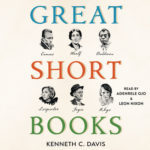
And Indie booksellers weigh in:
“Need something grand, something classic, uh…. something short to read, but don’t know where to start? Check out Kenneth Davis’s guide to Great Short Books and you’ll soon find just the right tale to delight your literary palate. For each suggestion, Davis gives us first lines, a plot summary, an author’s bio, a reason for reading it, and, finally, what you should read next from the author’s canon. Pick up a copy… you’ll be glad you did. You’re welcome!”—Linda Bond, Auntie’s Bookstore (Spokane, WA)
“Kenneth Davis has presented the perfect solution for too many books, not enough time—a collection of exceptional short books perfect for reading in a society seemingly without any free time. Many of the books may be familiar by name, some are obscure, some even forgotten, but all belong in the canon of superb literature. He teases with a brief synopsis and explains why each book deserves attention. An absolutely intriguing bonus is a short biographical sketch of each author, many of whom had fascinating but traumatic lives. It is the perfect book to provide comfort literature for busy readers.”—Bill Cusumano, Square Books (Oxford, Miss.)
More early reviews from readers at NetGalley.com
“GREAT SHORT BOOKS is a wonderful, breezy but deep look at the outstanding short books of the last 150 years. Kenneth C. Davis is a genius at summarizing each book and making the reader want to read said book post haste. This is a book I didn’t know the world needed but the world did.” –Tom O., reviewer
“…an incredibly valuable tool for book clubs and readers everywhere! Some authors/titles are well-known and others will be new discoveries….HIGHLY RECOMMENDED for any book group looking to find new titles or any reader who wants to know what to read next.” –Ann H. reviewer
“I found over a dozen new authors or titles I want to now read that were included in his main list, and the Further Reading at the end of each chapter and at the end of the volume itself.
As others have suggested, this is a great tool for Book Clubs!
Not Lit Crit, it is mostly focused on necessary, just-the-facts-mam information on one person’s reading of short books over a year. Well worth a read, and great for browsing!” –Stephen B., Librarian
“What better way to introduce new readers to more than 50 ‘short’ books. This handy book is full of non-spoiler descriptions and cultural context that situate these stories within our world.” –Kelsey W., librarian
S0urce: Great Short Books via NetGalley
I can’t wait to start talking about this book with readers everywhere.
Teachers, Librarians, Book Clubs and Other Learning Communities:
Invite me for a visit to your school, classroom, library, historical group, book club or conference.
The post GREAT SHORT BOOKS: A Year of Reading–Briefly first appeared on Don't Know Much.
May 23, 2023
Upcoming event: “So Many Books, So Little Time” Hudson Park Branch (NYPL)
Join me for an evening of conversation about GREAT SHORT BOOKS: A YEAR OF READING–BRIEFLY!
THURSDAY JUNE 8, 2023 6:30 PM
HUDSON PARK BRANCH–NEW YORK PUBLIC LIBRARY (66 LEROY STREET BETWEEN HUDSON AND VARICK)
This is a hybrid in-person and Zoom event. Register HERE.
Great Short Books is a guide to 58 books–most of them 200 pages or less–that I read during the pandemic lockdown. It is a celebration of reading–and the insight, inspiration, and instruction we can get from great fictiom
“An exciting guide to all that the world of fiction has to offer in 58 short novels — from ‘The Great Gatsby’ and ‘Lord of the Flies’ to the contemporary fiction of Colson Whitehead and Leïla Slimani — that, ‘like a first date,’ offer pleasure and excitement without commitment.” New York Times Book Review

“A short novel is like a great first date. It can be extremely pleasant, even exciting, and memorable. Ideally, you leave wanting more. It can lead to greater possibilities. But there is no long-term commitment.”
–From the Introduction to Great Short Books
Join in a lively conversation about books; the authors I read and researched; and why books matter. I will focus on some of the books and writers associated with downtown New York, including James Baldwin who lived for a time on Horatio Street. I will also address the grave danger of book banning and censorship, a topic covered in his history of paperback publishing, Two-Bit Culture (1984). A West Villager and regular patron of the Hudson Park Library, Kenneth C. Davis is also the author of the New York Times bestseller Don’t Know Much About History.
Q&A session to follow.
The post Upcoming event: “So Many Books, So Little Time” Hudson Park Branch (NYPL) first appeared on Don't Know Much.
May 18, 2023
The Divisive & Partisan History of “Memorial Day”
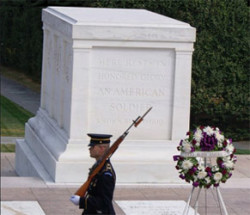
Tomb of the Unknown Soldier (Photo: Arlington National Cemetery) This memorial was created after the great losses of World War I.
America’s most solemn holiday should be free of rancor. But it never has been.
Army The Confederate Monument in Arlington National Cemetery is on its way out. The heated arguments over removing the Confederate flag and monuments to heroes and soldiers of the Confederacy in New Orleans and provide examples and reminders of the birth of Memorial Day.
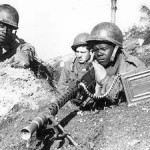
In the Korean War, the U.S. military was integrated. (Source: Library of Congress)
Waterloo, New York claimed that the holiday originated there with a parade and decoration of the graves of fallen soldiers in 1866. But according to the Veterans Administration, at least 25 places stake a claim to the birth of Memorial Day. Among the pack are Boalsburg, Pennsylvania, which says it was first in 1864.( “Many Claim to Be Memorial Day Birthplace” )
And Charleston, South Carolina, according to historian David Blight, points to a parade of emancipated children in May 1865 who decorated the graves of fallen Union soldiers whose remains were moved from a racetrack to a proper cemetery.
Born out of the Civil War’s catastrophic death toll as “Decoration Day,” Memorial Day is a day for honoring our nation’s war dead. A veteran of the Mexican War and the Civil War, John A. Logan, a Congressman and leader of the Grand Army of the Republic, established the first somber commemoration on May 30, 1868, in Arlington Cemetery, the sacred space wrested from property once belonging to Robert E. Lee’s family.( When Memorial Day was No Picnic by James M. McPherson.) The Grand Army of the Republic was a powerful fraternal organization formed of Civil War Union veterans and Logan issued “General Order N.11” calling for a day to decorate the graves of the fallen Union soldiers with flowers.
What can aid more to assure this result than cherishing tenderly the memory of our heroic dead, who made their breasts a barricade between our country and its foes? Their soldier lives were the reveille of freedom to a race in chains, and their deaths the tattoo of rebellious tyranny in arms. We should guard their graves with sacred vigilance.

Abraham Lincoln (November 1863) Photo by Alexander Gardner
From its inception, Decoration Day (later Memorial Day) was linked to “Yankee” losses in the cause of emancipation. Calling for the first formal Decoration Day, Union General John Logan wrote, “Their soldier lives were the reveille of freedom to a race in chains…”
In other words, Logan’s first Decoration Day was divisive— a partisan affair, organized by northerners.
In 1871, Frederick Douglass gave a Memorial Day speech in Arlington that focused on this division:
We are sometimes asked, in the name of patriotism, to forget the merits of this fearful struggle, and to remember with equal admiration those who struck at the nation’s life and those who struck to save it, those who fought for slavery and those who fought for liberty and justice.
I am no minister of malice. I would not strike the fallen. I would not repel the repentant; but may my “right hand forget her cunning and my tongue cleave to the roof of my mouth,” if I forget the difference between the parties to that terrible, protracted, and bloody conflict.

But the question remains: what inspired Logan to call for this rite of decorating soldier’s graves with fresh flowers?
The simple answer is—his wife.
After the war, while visiting Petersburg, Virginia – which fell to General Grant in 1865 after a deadly, year-long siege – Mary Logan learned about the city’s women who had formed a Ladies’ Memorial Association. Their aim was to show admiration “…for those who died defending homes and loved ones.”
Choosing June 9th, the anniversary of “The Battle of the Old Men and the Young Boys” fought in 1864, a teacher had taken her students to the city’s cemetery to decorate the graves of the fallen.
General Logan’s wife wrote to him about the practice. Soon after, he ordered a day of remembrance. Despite all the other claims of credit –which are somewhat besides the point– Petersburg’s celebration inspired the “first” Decoration Day.
The teacher and her students, it is worth noting, had placed flowers and flags on both Union and Confederate graves.As America wages its partisan wars at full pitch, this may be a lesson for us all.
More resources at the New York Times Topics archive of Memorial Day articles
The story of “The Battle of the Old Men and the Young Boys” is told in THE HIDDEN HISTORY OF AMERICA AT WAR (Now in paperback)
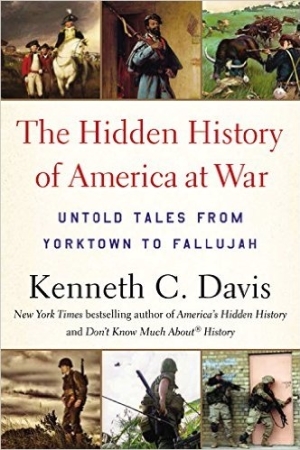
Now In paperback THE HIDDEN HISTORY OF AMERICA AT WAR: Untold Tales from Yorktown to Fallujah
The post The Divisive & Partisan History of “Memorial Day” first appeared on Don't Know Much.
May 17, 2023
Who Said It? (5-18-2023)

Lincoln is pictured in the center of the platform, hatless with his bodyguard, Ward Lamon, and Governor Andrew Curtin of Pennsylvania. Lincoln’s private secretaries, John Hay and John Nicolay, orator Edward Everett, and Gettysburg attorney and organizer David Wills may be among those near the president. Library of Congress //www.loc.gov/exhibits/gettysburg-addre...
Abraham Lincoln, November 19, 1863 -Gettysburg, PA.
With the approach of Memorial Day, I think it is always appropriate to read Lincoln’s Gettysburg Address as the perfect statement of what the holiday means.
This is a link to the Library of Congress online Exhibition about the Gettysburg Address:
This is the complete text of the Address, as recorded by Lincoln, in what is called the “Bliss Copy,” generally accepted as the standard version and the one which is inscribed at the Lincoln Memorial.
Four score and seven years ago our fathers brought forth on this continent a new nation, conceived in Liberty, and dedicated to the proposition that all men are created equal.
Now we are engaged in a great civil war, testing whether that nation, or any nation, so conceived and so dedicated, can long endure. We are met on a great battle-field of that war. We have come to dedicate a portion of that field, as a final resting place for those who here gave their lives that that nation might live. It is altogether fitting and proper that we should do this.
But, in a larger sense, we can not dedicate…we can not consecrate…we can not hallow this ground. The brave men, living and dead, who struggled here, have consecrated it, far above our poor power to add or detract. The world will little note, nor long remember what we say here, but it can never forget what they did here. It is for us the living, rather, to be dedicated here to the unfinished work which they who fought here have thus far so nobly advanced. It is rather for us to be here dedicated to the great task remaining before us—that from these honored dead we take increased devotion to that cause for which they gave the last full measure of devotion—that we here highly resolve that these dead shall not have died in vain—that this nation, under God, shall have a new birth of freedom—and that government: of the people, by the people, for the people, shall not perish from the earth.
The post Who Said It? (5-18-2023) first appeared on Don't Know Much.
Don’t Know Much About Memorial Day
Some governors would have us teach “the basics.” So here goes:
LET’S SET THE RECORD STRAIGHT— Memorial Day is about Slavery
It is not about swimsuit sales, the start of summer, or the hot dogs on the barbie.
Memorial Day, the most solemn occasion on the national calendar now honors the nation’s war dead. But it was born out of the the Civil War, which was fought because of slavery, America’s original sin. Memorial Day is about a nation “conceived in liberty” but born in shackles.
In these fraught times, when teaching history has become so contentious, we must tell it straight when we observe the history behind the holiday. Here are some basic facts:
1) Memorial Day was conceived as Decoration Day, first marked in May 30, 1868 by a proclamation of General John Logan, leader of a powerful Civil War veterans group. His original proclamation –“General Orders, No. 11”– read, in part: “Their soldier lives were the reveille of freedom to a race in chains and their deaths the tattoo of rebellious tyranny in arms.”
The day was an occasion for visiting the cemetery and decorating the graves of fallen Union soldiers who died in the Civil War.
2) The Civil War was fought over slavery. The “states rights” argument was put forward by “Lost Cause” apologists and eventually accepted by educators who wanted to diminish the significant role of slavery both in American history and in bringing about the war.

The Hidden History of America At War (paperback)
Read more about the divisive history of Memorial Day in an earlier post.
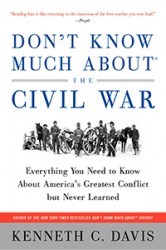
Don’t Know Much About the Civil War (Harper paperback, Random House Audio)
The truth matters. Now more than ever. So, once and for all, we must set the record straight.
As we observe Memorial Day, a day for honoring our nation’s war dead, let us emphasis these truths about America’s deep history of slavery.
Here are five important points that illustrate the through-line of slavery in American history, from the founding through the Civil War:
Enslaved people were in America before the Mayflower PilgrimsThomas Jefferson condemned slavery in drafting the Declaration of Independence but other Founders scrubbed the language from the nation’s “birth certificate”Slavery was “baked in” the U.S. Constitution in the three-fifths compromiseSlavery made the Civil War inevitableThe abolition of slavery after the Civil War did not end the stark divisions that continue to plague the United States todayREAD MORE in my article “Conceived in Liberty, Born in Shackles” (Social Education, March-April 2020)
The post Don’t Know Much About Memorial Day first appeared on Don't Know Much.
April 24, 2023
“Why Books Matter: ‘Books Are Weapons in the War of Ideas'”
It is National Library Week, and today April 24, is National Right to Read Day. It is a good time to talk about “Why Books Matter.”
“Efforts to ban books nearly doubled in 2022 over the previous year, according to a report published Thursday by the American Library Association.” (New York Times, March 27, 2023).
In the current environment of book banning and the attempt to alter what we teach in American History, I believe we are in the midst of a “War of Ideas.” It is one reason I wrote this article: “Why Books Matter: ‘Books Are Weapons in the War of Ideas'” It appears in the January-February issue of Social Education, the journal of the National Council for the Social Studies (NCSS).
It offers an overview of censorship and my thoughts on the current conflict. Book banning has a long history. But we are at a significant moment when the stakes have rarely been higher.
You can also read my earlier related piece: “When Robin Hood Was Blacklisted”
And as I point out, more than half of the 58 writers included in my new book, Great Short Books: A Year of Reading–Briefly, were also banned, censored, or suppressed. Several had their works burned.

The post “Why Books Matter: ‘Books Are Weapons in the War of Ideas'” first appeared on Don't Know Much.
April 13, 2023
What do we do about Mr. Jefferson?
(Revision of April 13, 2012 post)
“That these are our grievances which we have thus laid before his majesty, with that freedom of language and sentiment which becomes a free people claiming their rights, as derived from the laws of nature, and not as the gift of their chief magistrate: …. (Kings) are the servants, not the proprietors of the people.”
–Thomas Jefferson, A Summary View of the Rights of British America (1774)
Born on April 13, 1743 at Shadwell, his father’s estate in Albermarle County, Virginia, Thomas Jefferson embodied what I call the “Great Contradiction”–that a nation “conceived in liberty” was also born in shackles.
Read my article on teaching the “American Contradiction” in Social Education.
Jefferson was the son of a planter and surveyor, Peter Jefferson and his wife, Jane Randolph Jefferson, who came from one of Virginia’s wealthiest families. Thomas Jefferson’s father had moved the family to the Tuckahoe plantation owned by William Randolph, which Peter Jefferson managed as executor.
The third child in a family of ten and oldest son, Thomas was a bookish boy who studied with a local clergyman and later at a school in Fredericksburg with Reverend James Maury who taught Jefferson the classics in their original languages. Thomas was fourteen when his father died, leaving the boy head of an estate with about 2,500 acres and thirty enslaved people.
The Declaration’s future author distinguished himself early as a scholar at the College of William and Mary, and gained admission to the Virginia bar in 1767. His literary prowess, demonstrated in A Summary View of the Rights of British America, prompted John Adams to put Jefferson forward as the man to write the Declaration, a task he accepted with reluctance.
Most of the war years were spent in Virginia as a legislator and later as governor, a period of some controversy as he was criticized for failing to aggressively defend Virginia against British attacks. He barely escaped capture in Richmond in 1781, a story told in my book In the Shadow of Liberty.
After his wife’s death in 1783, he served as ambassador to France, where he could observe firsthand the French Revolution. It was here that Jefferson is believed to have begun his relationship with Sally Hemings, the enslaved 14-year-old thought to be half-sister of Jefferson’s dead wife, Martha.
Returning to America in 1789, Jefferson became Washington’s secretary of state and began to oppose what he saw as a too-powerful central government under the new Constitution, bringing him into a direct confrontation with his old colleague John Adams and, more dramatically, with Alexander Hamilton.
Running second to Adams in 1796, he became vice president, chafing at the largely ceremonial role. In 1800, Jefferson and fellow Democratic-Republican Aaron Burr tied in the Electoral College vote, and Jefferson took the presidency in a tense and controversial House vote that required more than 30 ballots.
While President, Jefferson engineered the Louisiana Purchase and wrote what may be his second most famous lines in a letter addressing religious freedom under the new American government.
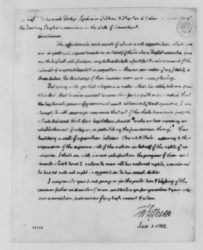
Jefferson to Danbury Baptists (Monticello)
i
“Believing with you that religion is a matter which lies solely between man and his God, that he owes account to none other for his faith or his worship, that the legislative powers of government reach actions only, and not opinions, I contemplate with sovereign reverence that act of the whole American people which declared that their legislature should ‘make no law respecting an establishment of religion, or prohibiting the free exercise thereof,’ thus building a wall of separation between church and State. Adhering to this expression of the supreme will of the nation in behalf of the rights of conscience, I shall see with sincere satisfaction the progress of those sentiments which tend to restore to man all his natural rights, convinced he has no natural right in opposition to his social duties.”
–Thomas Jefferson
Letter to the Danbury Baptist Association, (January 1, 1802)
After two terms, he returned to his Monticello home to complete his final endeavor, building the University of Virginia. As he lay dying, Jefferson would ask what the date was, holding out, like John Adams, until July 4, 1826, the fiftieth anniversary of the Declaration.
With the advantage of hindsight, cynicism about Thomas Jefferson is easy. But the baffling question remains: How could a man who embodied the idealism of the Enlightenment enslave Black people –and it is widely assumed — father children by one of them? What do we do about Thomas Jefferson?
There is no satisfying answer. Earlier in his life, he had unsuccessfully argued against aspects of slavery. At worst, Jefferson may not have thought of slaves as men, not an unusual notion in his time. And he was a man of his times. He was completely dependent upon slavery for his financial life and the political power of his southern slave-holding class. Like other men, great and small, he was not perfect.
Jefferson’s life, writings, and politics are discussed in Don’t Know Much About History and Don’t Know Much About the American Presidents from which this material is adapted.
His relationship with the enslaved people of Monticello is explored in detail in my book In the Shadow of Liberty.
The post What do we do about Mr. Jefferson? first appeared on Don't Know Much.
April 12, 2023
GREAT SHORT BOOKS: A Year of Reading–Briefly

Two boxes of beautiful finished books have arrived (Author photo)
GREAT SHORT BOOKS:
A YEAR OF READING — BRIEFLY
NOW AVAILABLE
Scribner/Simon & Schuster and Simon Audio (Unabridged audio download)

“An exciting guide to all that the world of fiction has to offer in 58 short novels — from ‘The Great Gatsby’ and ‘Lord of the Flies’ to the contemporary fiction of Colson Whitehead and Leïla Slimani — that, ‘like a first date,’ offer pleasure and excitement without commitment.” New York Times Book Review
Booklist “Editors’ Choice Adult Books 2022″
“…The most exceptional of the best books of 2022 reviewed in Booklist…”
“Delightfully accessible, Great Short Books: A Year of Reading–Briefly presents 58 fact-filled reviews of short books, a smorgasbord of titles sure to entice readers.” –Cheryl McKeon, Shelf Awareness
“I consider Davis’ ‘Great Short Books’ a gift to readers, a true treasure trove of literary recommendations.” —Sue Gilmore, SFGate
“Anyone who’s eternally time-strapped will treasure Kenneth C. Davis’ Great Short Books. This nifty volume highlights 58 works of fiction chosen by Davis for their size (small) and impact (enormous). Each brisk read weighs in at around 200 pages but has the oomph of an epic.” —Bookpage Full Review
“An entertaining journey with a fun, knowledgeable guide…. “ Kirkus Reviews
“A must-purchase for public and school libraries.” ALA Booklist
FIRST TRADE REVIEWS FROM KIRKUS, PUBLISHERS WEEKLY, BOOKLIST
“Davis feels that novels of 200 pages or less often don’t get the recognition they deserve, and this delightful book is the remedy…A must-purchase for public and school libraries.” *Starred Booklist review
“An entertaining journey with a fun, knowledgeable guide…. His love of books and reading shines through. From 1759 (Candide) to 2019 (The Nickel Boys), he’s got you covered.” –Kirkus Reviews
Full KIRKUS review here
“Davis’s conversational tone makes him a great guide to these literary aperitifs. This is sure to leave book lovers with something new to add to their lists.” FULL PUBLISHERS WEEKLY REVIEW here
During the lock-down, I swapped doom-scrolling for the insight and inspiration that come from reading great fiction. Inspired by Boccaccio’s “The Decameron” and its brief tales told during a pandemic, I read 58 great short novels –not as an escape but an antidote.
“A short novel is like a great first date. It can be extremely pleasant, even exciting, and memorable. Ideally, you leave wanting more. It can lead to greater possibilities. But there is no long-term commitment.”
–From “Notes of a Common Reader,” the Introduction to Great Short Books
Read “The Antidote to Everything,” an excerpt from the Introduction published on Lit Hub
The result is a compendium that goes from “Candide” to Colson Whitehead, and Edith Wharton to Leïla Slimani. And yes, Maus and many other Banned Books and Writers.

What “A Year of Reading–Briefly” looks like

Voltaire in Great Short Books
Art © Sam Kerr

Edith Wharton in Great Short Books
Art © Sam Kerr
Advance Praise for Great Short Books: A Year of Reading—Briefly
“GREAT SHORT BOOKS is a fascinating, thoughtful, and inspiring guide to a marvelous form of literature: the short novel. You can dip into this book anywhere you like, but I found myself reading it cover-to-cover, delighting in discovering new works while also revisiting many of my favorites. GREAT SHORT BOOKS is itself a great book—for those who are over-scheduled but want to expand their reading and for those who will simply delight in spending time with a passionate fellow reader who on every page reminds us why we need and love to read.”
–Will Schwalbe, New York Times bestselling author of THE END OF YOUR LIFE BOOK CLUB
“This is the book that you didn’t know you really needed. I began digging into this book as soon as I got it, and it was such a delight to read beautiful prose, just a sip at a time, with Kenneth Davis’ notes to give me context and help me more fully appreciate the stories. Keep this book near your bed or on your coffee table. It will be read and loved.”
–Celeste Headlee, journalist and author of WE NEED TO TALK and SPEAKING OF RACE

Recording audio book of Great Short Books (Sept. 2022) Photo by Katherine Cook
From hard-boiled fiction to magical realism, the 18th century to the present day, Great Short Books spans genres, cultures, countries, and time to present a diverse selection of acclaimed and canonical novels—plus a few bestsellers. Like browsing in your favorite bookstore, this eclectic compendium is a fun and practical book for any passionate reader hoping to broaden their collection— or anyone who is looking for an entertaining, effortless reentry into reading.
Listen to a sample of the audio book of Great Short Books

And Indie booksellers weigh in:
“Need something grand, something classic, uh…. something short to read, but don’t know where to start? Check out Kenneth Davis’s guide to Great Short Books and you’ll soon find just the right tale to delight your literary palate. For each suggestion, Davis gives us first lines, a plot summary, an author’s bio, a reason for reading it, and, finally, what you should read next from the author’s canon. Pick up a copy… you’ll be glad you did. You’re welcome!”—Linda Bond, Auntie’s Bookstore (Spokane, WA)
“Kenneth Davis has presented the perfect solution for too many books, not enough time—a collection of exceptional short books perfect for reading in a society seemingly without any free time. Many of the books may be familiar by name, some are obscure, some even forgotten, but all belong in the canon of superb literature. He teases with a brief synopsis and explains why each book deserves attention. An absolutely intriguing bonus is a short biographical sketch of each author, many of whom had fascinating but traumatic lives. It is the perfect book to provide comfort literature for busy readers.”—Bill Cusumano, Square Books (Oxford, Miss.)
More early reviews from readers at NetGalley.com
“GREAT SHORT BOOKS is a wonderful, breezy but deep look at the outstanding short books of the last 150 years. Kenneth C. Davis is a genius at summarizing each book and making the reader want to read said book post haste. This is a book I didn’t know the world needed but the world did.” –Tom O., reviewer
“…an incredibly valuable tool for book clubs and readers everywhere! Some authors/titles are well-known and others will be new discoveries….HIGHLY RECOMMENDED for any book group looking to find new titles or any reader who wants to know what to read next.” –Ann H. reviewer
“I found over a dozen new authors or titles I want to now read that were included in his main list, and the Further Reading at the end of each chapter and at the end of the volume itself.
As others have suggested, this is a great tool for Book Clubs!
Not Lit Crit, it is mostly focused on necessary, just-the-facts-mam information on one person’s reading of short books over a year. Well worth a read, and great for browsing!” –Stephen B., Librarian
“What better way to introduce new readers to more than 50 ‘short’ books. This handy book is full of non-spoiler descriptions and cultural context that situate these stories within our world.” –Kelsey W., librarian
S0urce: Great Short Books via NetGalley
I can’t wait to start talking about this book with readers everywhere.
Teachers, Librarians, Book Clubs and Other Learning Communities:
Invite me for a visit to your school, classroom, library, historical group, book club or conference.
The post GREAT SHORT BOOKS: A Year of Reading–Briefly first appeared on Don't Know Much.
April 3, 2023
Don’t Know Much About ® the “Marshall Plan”
(Originally posted in 2012; Revised April 3, 2023)
On April 3, 1948, President Truman signed into law the Economic Recovery Act, better known as the “Marshall Plan.”
Over the next four years, Congress appropriated $13.3 billion for European recovery. This aid provided much needed capital and materials that enabled Europeans to rebuild the continent’s economy.
For the United States, the Marshall Plan provided markets for American goods, created reliable trading partners, and supported the development of stable democratic governments in Western Europe. Congress’s approval of the Marshall Plan signaled an extension of the bipartisanship of World War II into the postwar years.
–“Marshall Plan” (National Archives)
“Foreign aid” is not just “do-gooder” national policy. It is an effective means to influence future outcomes. There is no better example than the program that came to be called the “Marshall Plan.”
On June 5, 1947, Secretary of State George C. Marshall gave Harvard’s commencement address, introducing and justifying the European Recovery Program, which became known as the Marshall Plan.
Marshall (born December 31, 1880) had been the Chief of Staff of the U.S. Army during World War II and Winston Churchill hailed him as the “true organizer of victory.” The plan, part of the Cold War program of “Containment” championed by George F. Kennan, and put forth by President Harry S. Truman, is credited with restoring the economies of post-World War II western Europe. At Harvard, Marshall said:
The truth of the matter is that Europe’s requirements for the next three or four years of foreign food and other essential products—principally from America—are so much greater than her present ability to pay that she must have substantial additional help, or face economic, social and political deterioration of a very grave character. …Aside from the demoralizing effect on the world at large and the possibilities of disturbances arising as a result of the desperation of the people concerned, the consequences to the economy of the United States should be apparent to all. It is logical that the United States should do whatever it is able to do to assist in the return of normal economic health in the world, without which there can be no political stability and no assured peace. Our policy is directed not against any country or doctrine but against hunger, poverty, desperation, and chaos.
Conceived by Undersecretary of State Will Clayton and first proposed by Secretary of State Dean Acheson, the Marshall Plan pumped more than $12 billion into selected war torn European countries during the next four years. (The countries participating were Austria, Belgium, Denmark, France, West Germany, Great Britain, Greece, Iceland, Italy, Luxembourg, the Netherlands, Norway, Sweden, Switzerland and Turkey.)
It provided the economic side of President Truman’s policy of “Containment” by removing the economic dislocation that might have fostered Communism in Western Europe. It also set up a Displaced Persons Plan under which some 300,000 Europeans, many of them Jewish survivors of the Holocaust, were granted American citizenship. By most accounts, the Marshall Plan was the most successful undertaking of the United States in the post-war era and is often cited as the most compelling argument in favor of foreign aid.
By most measures, the Marshall Plan must be considered an enormously successful undertaking that helped return a devastated Europe to health. allowing free market democracies to flourish while Eastern Europe, hunkered down under repressive Soviet controlled regimes, stagnated socially and economically.
Marshall was awarded the Nobel Peace Prize in 1953 before his death on October 16, 1959. For more about Marshall, here is a link to the nonprofit Marshall Foundation.
You can read more about the Marshall Plan and the Cold War era in the newly revised and updated edition of Don’t Know Much About History 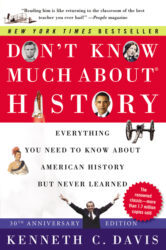 and about the end of World War II in The Hidden History of America at War.
and about the end of World War II in The Hidden History of America at War.

The post Don’t Know Much About ® the “Marshall Plan” first appeared on Don't Know Much.
March 29, 2023
Don’t Know Much About® “His Accidency,” John Tyler
(Originally posted March 29, 2011; reposted March 29, 2023)
It is quite possible that all you know about the 10th President, John Tyler, is that he is the hind-part of a memorable campaign slogan: Tippecanoe and Tyler too!
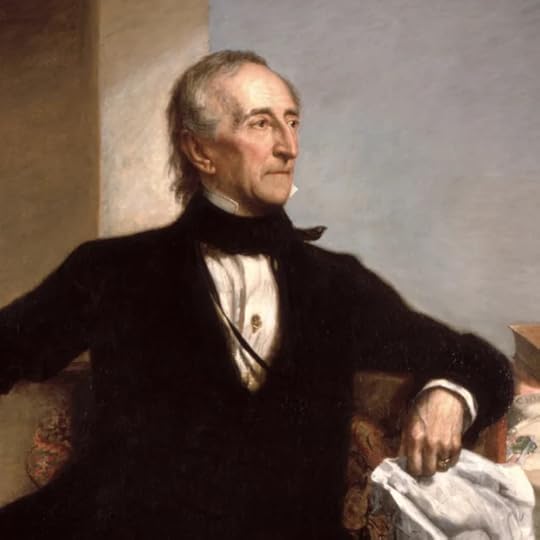
Tenth POTUS, John Tyler (Image White House.gov https://www.whitehouse.gov/about-the-...
John Tyler was born on March 29, in 1790, at Greenway, a James River plantation in Charles City County, Virginia, between Richmond and Williamsburg. The son of a wealthy planter and judge, he was raised among Virginia’s elite, attending William and Mary College. He graduated at age 17 and then studied law, earning admission to the bar in 1809.
Tyler served in Congress in both the House and Senate, as well as the Virginia legislature, and in 1840 was named the running mate of William Henry Harrison, a fellow Virginian known as the hero of the Battle of Tippecanoe –fought against a confederation of Native American nations led by Tecumseh in 1811.
“Tippecanoe and Tyler too” defeated the incumbent Martin Van Buren, and Harrison took the oath of office on March 4, 1841, delivering the longest inaugural speech in history. He then took ill and died of pneumonia on April 4, 1841, becoming the first President to die in office.
That made Tyler the first Vice-President to succeed to the office on the death of a President. The chief controversy of his early administration was over his legal status. Was Tyler actually the President or merely the “acting President?” He regarded himself as President and even returned mail unopened that was addressed to “The Acting President.” But many derided him as His Accidency.
Another distinction was Tyler’s marriage, following the death of his first wife Letitia Christian in 1842, to Julia Gardiner. The daughter of a wealthy New York politician, she had created a minor scandal in polite society by appearing in an advertisement at age 19. When they married in New York City in 1844, she was 24; Tyler was 54 and the 30-year age difference raised eyebrows and caused a rift with some of Tyler’s grown children. However, this wedding earned Tyler the distinction of being the first President to be married while in office.
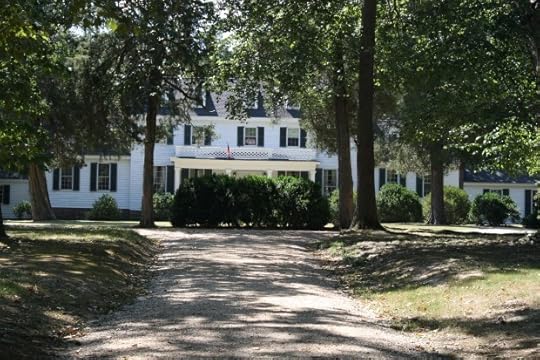
Sherwood Forest Virginia Home of President John Tyler (Photo credit Kenneth C. Davis, 2010)
His single term ended and he failed to be renominated. Tyler gave way to the the candidacy of James K. Polk rather than run as third-party candidate. Tyler retired to this plantation home, Sherwood Forest, which is a National Historic landmark in Virginia.
His final distinction was his election to the Provisional Congress of the Confederacy and his failed attempt to broker a peace deal before the Civil War broke out. But in November 1861, Tyler was elected to the Confederate House of Representatives, becoming the first former President to be elected to serve in another government –the Confederacy.
Tyler died on January 18, 1862 before taking his seat in the Confederate Congress. Although he had planned to be buried at his Sherwood Forest home, he is buried in Richmond.
For many years after the Civil War, his resting place was officially ignored. In 1915, 50 years after the Civil War ended, the Congress voted to erect a memorial stone over his grave.
Read more about Tyler in Don’t Know Much About® the American Presidents 
Don’t Know Much About® the Civil War

The post Don’t Know Much About® “His Accidency,” John Tyler first appeared on Don't Know Much.




